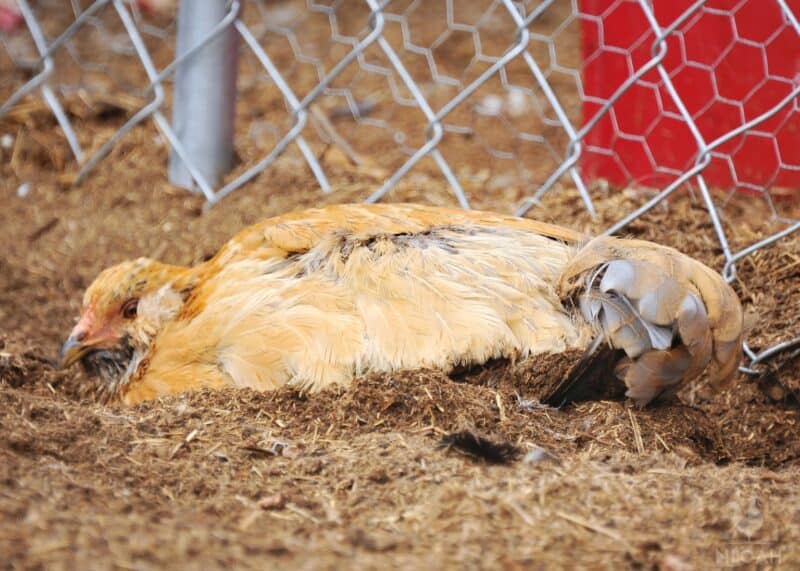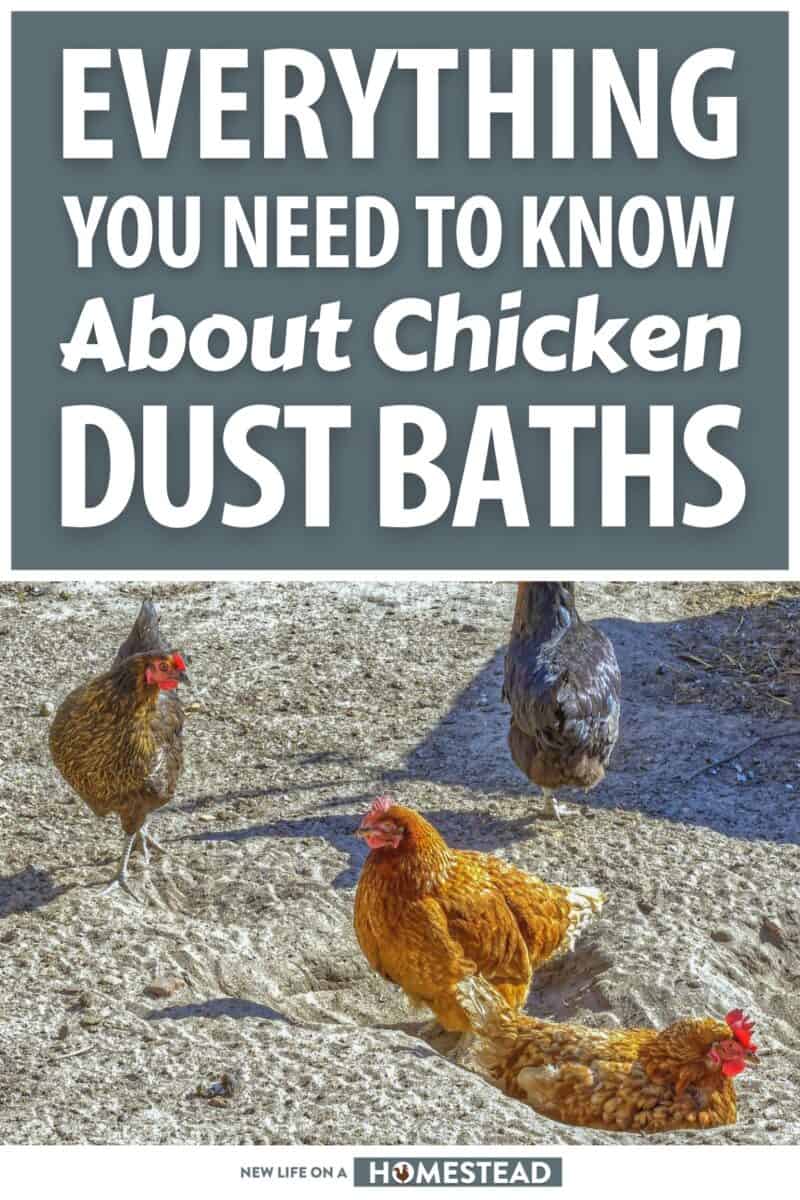If you keep any kind of animals on the farm or on your homestead, you know good and well that they get dirty. You also know that it is up to you to help them keep clean, or at least clean enough.

Animals that stay dirty are more likely to get sick and are prone to injuries get infected.
No matter the species, regular bathing means fewer problems and reduced medical expenses, not to mention happier animals! This certainly counts for our feathered friends.
Compared to other species, chickens are more fastidious when it comes to their own personal hygiene, but they still need help and this is complicated by the fact that getting a chicken soaking wet is a bad idea. Instead, chickens take regular dust baths to stay clean.
Putting together the right dust bath for your chickens to use means their feathers will stay in tip-top condition and they will deal with fewer parasites that can make them miserable. We will tell you everything you need to know in this article.
Aren’t Normal Baths Okay for Chickens?
Most birds will splash around in the water to get clean, and the same goes for chickens. The problem is that most birds, chickens included, should not get soaking wet if they can avoid it. And that means that usual bathing is not something you should do regularly.
This is because when feathers get wet they are much more likely to break and become damaged.
It is also a problem for the bird because their feathers provide vital insulation that helps them regulate their body temperature, protects them from the sun, and of course helps them to fly (assuming they can).
When feathers are soaking wet, it exposes the chicken to all sorts of problems and can make life miserable for them, and maybe for you.
Nonetheless, they need to get clean somehow. Chickens do, in fact, get clean but they do so using dirt for the job in a process known as dust bathing. What? How can a chicken get clean with dust bathing?
What Can a Dust Bath Do for Chickens?
Dust baths are a regular, and essential, part of life for chickens. It’s not just having fun by rolling and flapping around in the dirt although they do that too! Chickens NEED their dust baths to keep feathers maintained and to stay healthy.
Chickens dust bathe for several reasons:
1. To remove or impede any external parasites such as mites, lice, and ticks that may be hanging around in their feathers.
These are nasty little creatures that can make your chickens very uncomfortable, and even make them sick. Dust and dirt washing can dislodge them and their eggs, or even smother them.
2. To help keep their feathers in good condition. When preening, chickens use a dust bath to remove any oils or gunk that may have accumulated on their feathers, and also to straighten and align individual strands of each feather. Healthy feathers are critical for healthy chickens, and they’ll stay looking good, too!
3. To regulate their body temperature. Messy feathers mean a chicken will be too hot when it is hot, and too cold when it is cold. Dust bathing is an important step in preventing exposure.
4. It helps chickens be happy. Chickens instinctively want to dust bathe, and can often be spotted helping out their relatives and close friends. You will always see that your birds have more of a pep in their step whenever they are finished bathing.
Though it seems weird to us, getting nice and dusty is actually really important for the health of your chickens.
In the next section, we will learn how to properly create a dust bath that is not only effective but is one our chickens want to use.
How to Make a Chicken Dust Bath
Making a dust bath is a cinch, and you can place it either in a designated spot in your yard or in a container to make it portable.
The “ingredients” in a dust bath are commonly available and inexpensive, maybe even free, and you’ll have several of them on hand already, probably. Anyway, let’s get to it.
Pick a Spot or Container
Your chickens will naturally make use of dirt and grit that they find out in nature, and don’t need a special container to do it. However, you might choose to put your dust bath in a container that is easy to carry and easy to cover in order to help keep it clean(er) and dry.
If you want to put the dust bath on the ground, simply take care to pick a spot that stays dry and remove all the rocks, gravel, and other debris from it that might hurt your chickens. Clear away grass, too.
If you want it in a container, pick something long and low with a lid that is easy to move around and can be covered. Don’t pick a container with sides that are too tall, as your chickens will be less inclined to use it.
Remember: bigger and/or wider is better when it comes to dust baths because your birds might bathe in pairs, or even more, at once!
Use Good, Clean Soil and Fine Dry Sand
A great dust bath mix for chickens is about 50/50 clean soil to fine, dry sand. If you have suitable soil on your property, great, just use it.
If not, bagged topsoil works just fine. Same thing with sand. Smaller, sharper grains work better and be sure to sift them if you aren’t buying bagged sand.
Never Use Soil with Clay in It!
One quick note: never use dirt that has noticeable clay content. This won’t work for chickens, and will instead turn into a big mess and goop up their feathers. If in doubt, buy some bagged soil or dirt from a landscaping supply company.
Add Either Wood Ash or DE
Aside from the soil and sand, you can add a scoop or two of either wood ash or DE (diatomaceous earth) to your dust bath mix to help your chickens get even cleaner. These two ingredients serve the same purpose, so it’s really up to you which one you choose.
Either will help kill off microbes and also eliminate insect and arthropod pests with prejudice. One quick note, do make sure any wood ash you add is very fine and completely cool to the touch! No fresh embers in the dust bath, eh?
Keep it Dry
If your dust bath is in a container, keep it dry by stashing it in a shed or barn when rainy weather approaches.
There won’t be much you can do to keep a ground-level dust bath dry, but you can always move it to a drier location if it gets waterlogged.
Maintain Your Dust Bath
Once your chickens start using the dust bath, you might find that they go through it pretty quickly. If so, simply add more of the ingredients until they have enough to work with. Big plumes of dust in the air is a good sign!
Consider Putting Herbs in Your Birds’ Dust Bath
One trick that many keepers swear by is adding dried herbs to their chicken’s dust bath mix. The most popular herbs to use are lavender, mint, oregano, and basil, but you can really add anything that smells nice and is safe for chickens.
Most also herbs have antimicrobial properties and will further help to condition the feathers of your birds.
Will Dust Baths Work for Chickens in Winter?
Yes, and it is their primary way to bathe in the winter time. If you use a container dust bath, you can just set it out for them to use regularly, or even place it in the coop or run.
If you want a permanent in- or on-ground dust bath, consider constructing a cover over it to keep snow and sleet off.
Dust Baths for Baby Chicks
Baby chicks take dust baths just like adult birds once they are a couple of weeks old. You don’t need to do anything different for them regarding the mixture, though a smaller container with even finer dirt and sand that will fit in their enclosure is a good idea.
Frequently Asked Questions
Yes. Sand is totally fine for a dust bath, and is indeed helpful. Just make sure it is very fine grained, sharp, and sift it before using if you are using sand sourced from the environment.
Coarse, soft sand does not have much in the way of cleaning power and unsifted sand might have contaminants you don’t want in there.
Bigger is better, within reason. Chickens really get into dustbathing, lying on the ground, flipping over, and flapping their wings. And they like to do it together, much of the time.
In short, it should be no smaller than the size of one adult chicken lying prone with wings spread, and preferably big enough to accommodate several adults at once.

Tom has lived and worked on farms and homesteads from the Carolinas to Kentucky and beyond. He is passionate about helping people prepare for tough times by embracing lifestyles of self-sufficiency.

I have my chicken’s coop elevated so they do their dust baths under the coop. It’s usually just the local, natural dirt but I’ll toss in a few scoops of DE every once in awhile. I’ll know when they hit a pocket of DE when they come out white-ish.